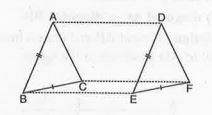Consider an acute angled ΔABC. Let AD, BE and CF be the altitudes drawn from the vertice to the opposite sides. Prove that : EFa+FDb+DEc=R+rR. Solution in Bengali
FEa+FDb+DEc=acosAa+bcosBb+ccosCa
=cosA+cosB+cosC
≤32
Topper's Solved these Questions
- BOOK - CENGAGE PUBLICATIONCHAPTER - PROPERTIES AND SOLUTIONS OF TRIANGLEEXERCISE - Concept application exercise 5.108videos
PROPERTIES AND SOLUTIONS OF TRIANGLE
- BOOK - CENGAGE PUBLICATIONCHAPTER - PROPERTIES AND SOLUTIONS OF TRIANGLEEXERCISE - Concept application exercise 5.114videos
PROPERTIES AND SOLUTIONS OF TRIANGLE
- BOOK - CENGAGE PUBLICATIONCHAPTER - PROPERTIES AND SOLUTIONS OF TRIANGLEEXERCISE - Concept application exercise 5.87videos
PROPERTIES AND SOLUTIONS OF TRIANGLE
- BOOK - CENGAGE PUBLICATIONCHAPTER - PROGRESSION AND SERIESEXERCISE - ARCHIVES (NUMERICAL VALUE TYPE )8videos
PROGRESSION AND SERIES
- BOOK - CENGAGE PUBLICATIONCHAPTER - RELATIONS AND FUNCTIONSEXERCISE - All Questions1119videos
RELATIONS AND FUNCTIONS
Similar Questions
In ΔABC, if r1<r2<r3, then find the order of lengths of the sides
06:40View SolutionRegular pentagons are inscribed in two circles of radius 5and 2 units respectively. The ratio of their areas is
08:06View SolutionIf the incircle of the triangle ABC passes through its circumcenter, then find the value of 4sin.A2sin.B2sin.C2
02:03View SolutionLet Sk,k=1,2,….100 denote the sum of the infinite geometric series whose first term is k−1K! and the common
ration is 1k then the value of (100)2100!+Σ100k=1|(k^2-3k+1)S_k| is ____________View SolutionIf the function f:[1,∞)→[1,∞) is defined by f(x)=2x(x−1), then find f−1(x)
04:25View SolutionIn an acute angle triangle ABC,AD,BE and CF are the altitudes,then (EF)/(a)+(FD)/(b)+(DE)/(c) is equal to -
02:25View SolutionIn an acute angled triangle ABC, let AD,BE and CF be the perpendicular opposite sides of the triangle. The ratio of the product of the side lengths of the triangles DEF and ABC, is equal to
04:48View SolutionIf in a ΔABC,AD,BEandCF are the altitudes and R is the circumradius, then find the radius of the DEF.
04:52View SolutionIn an acute angle ΔABC, let AD, BE and CF be the perpendicular from A, B and C upon the opposite sides of the triangle. (All symbols used have usual meaning in a tiangle.)
The orthocentre of the ΔABC, is the04:10View SolutionIn a scalene triangle ABC , AD and CF are the altitudes drawn from A and C on the sides BC and AB respectively. If the area of the triangle ABC and BDF are 18sq.units and 2 sq. units respectively and DF = 2√2 , then R =
05:22View SolutionΔABC లో AD, BE , CF లు A,B C శీర్షాల నుంచి ఎదుటి భుజాలకు గీసిన లంబాలయితే 1 / AD + 1 / BE + 1 CF = 1 /r అని చూపండి.
06:53View SolutionThe altitudes from the vertices A,B,C of an acute angled triangle ABC to the opposite sides meet the circumcircle at D,E,F respectively . Then EFBC=
02:57View SolutionIn ΔABC and ΔDEF , AB = DE, AB∣∣DE, BC = EF and BC∣∣EF. Vertices A, B and C are joined to vertices D, E and F respectively (See fig.)
 Show that AD∣∣CF and AD=CF.04:10View Solution
Show that AD∣∣CF and AD=CF.04:10View SolutionIn ΔABC, if AD , BE , CF are the perpendiculars drawn from the vertices A, B, C to the opposite sides, shot that
1AD+1BE+1CF=1rand(ii)AD.BE.CF=(abc)28R3=8Δ3abc04:10View SolutionIn an acute angled triangle ABC, let AD,BE and CF be the perpendicular opposite sides of the triangle. The ratio of the product of the side lengths of the triangles DEF and ABC, is equal to
04:22View SolutionIn an acute angle ΔABC, let AD, BE and CF be the perpendicular from A, B and C upon the opposite sides of the triangle. (All symbols used have usual meaning in a tiangle.)
The orthocentre of the ΔABC, is the04:39View Solution

